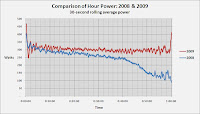I've been in "downsizing" mode and have been on a reasonably rigorous workout regimen. As is my wont, I've adopted some technology assists and, in particular, utilize a couple of iPhone apps. One of the ones I use on days when I run is called "Runmeter" by abvio. It uses the GPS in the iPhone to yield distance, time, pace, altitude gain and loss, and others. It exports my path to Google Maps as well. If I select, it will Tweet my run and people can follow me and, when they tweet replies, it will speak them to me. I don't use this option though.
To the point of this post, once weight is entered into the program, it tells calories used (of course, these food calories are really kilocalories) and time. This can be converted to average power used during the run. it's as simple as plugging "471*kilocalories/(2287*seconds) in watts" into Google search bar. Unfortunately, the resulting number, about 860 watts, seems highly implausible if not downright ridiculous. That's over one horsepower for 38 minutes, and I'm no world class athlete. I'm hardly a neighborhood class athlete! Perhaps it's calculating the total, including my base metabolism of about 100 watts. That would make the increment of the running 760 watts or right at one horsepower. Also not possible.
And yet I've read that very strenuous physical exertion can burn on the order of 600 kilocalories/hour. This is just shy of 700 watts. On the other hand, many sources say that world class athletes can produce 1000 watts very briefly and a much smaller number for any significant length of time. For example, the graph at left shows the continuous power production of Masters Men (35-39) Hour Record holder (bicycle) Jayson Austin's rides in 2008 and 2009 (click to enbiggen). In 2009 his average power output over the hour was 302 watts.
I think that there's not much question that there's a problem here someplace! My suspicion is that the athlete figures are "external work" only, i.e., force exerted against the environment times speed. Then, the "food energy burned" figures count that as well as the internal energy burned to produce that work. If this is the case then, if I knew my rate of performing external work, what I'll call "athletic power," then I could use that and the internal metabolic power to calculate my efficiency of energy utilization. In my cycle of rotation of exercise, one of my workouts is a bicycle ride. One can get a "power meter" to measure actual athletic power. I'll post results when I get them.
This actually is pertinent to me as another iPhone app, Lose It, tracks my weight loss progress. In it, I log my food intake (it scans barcodes and has an extensive list of foods plus the ability to create your own foods and recipes) and my exercise calories to predict when I will reach my goal weight. Its evaluation of my exercise is similar to the output of the run meter when I plug in my weight, exercise type, and pace. It also tells me, based on my desired kilocalorie deficit (the difference between my daily "burn" and my intake), how many kilocalories I have left to eat on a given day. If my exercise kilocalories burned are less than the apps indicate, I may be eating more than I should given my desired deficit. On the other hand, the weight loss progress is good so I don't think I'll modify the inputs.

No comments:
Post a Comment